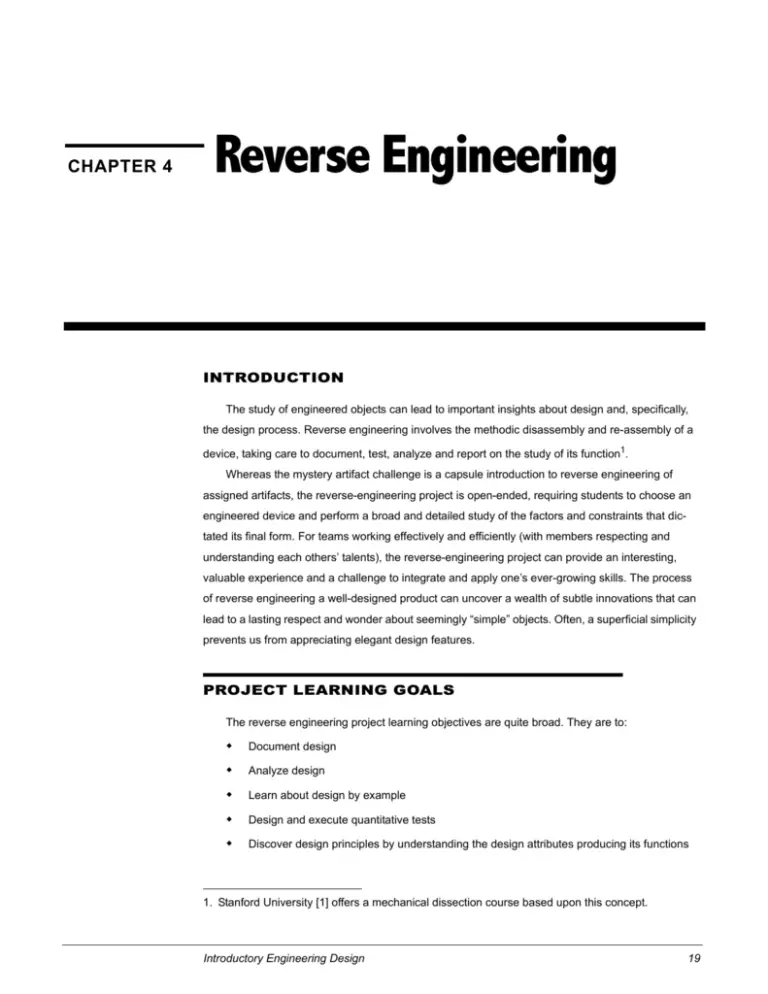Reverse Engineering for Technical Writers

Reverse engineering, the process of understanding and documenting an existing system by analyzing its structure, function, and implementation, offers invaluable benefits for technical writers tasked with developing documentation for complex and opaque technologies.

Benefits of Reverse Engineering for Technical Writers:

- Accurate and Comprehensive Documentation: By thoroughly studying the underlying architecture and functionality of a system, technical writers gain a deep understanding that enables them to produce precise and exhaustive documentation.
- Early Identification of Issues: Reverse engineering helps uncover potential problems and inconsistencies early on, allowing writers to flag issues for correction during the development process.
- Targeted Content: Understanding how a system functions allows writers to tailor documentation specifically to the needs of different user groups, providing targeted and relevant information.
- Improved Collaboration: Reverse engineering fosters collaboration between technical writers and system engineers, ensuring that documentation is aligned with the technical specifications and the intended functionality of the system.
- Knowledge Transfer: The insights gained through reverse engineering can be disseminated across the organization, contributing to a shared understanding of the system’s complexities.
Process of Reverse Engineering for Technical Writing:
- Gather System Information: Collect available documentation, interview stakeholders, and establish a clear understanding of the system’s purpose and scope.
- Analyze System Structure: Examine the system’s architecture, components, and interconnections to understand the overall design and data flow.
- Identify Functionality: Explore the system’s capabilities and behaviors under various conditions to document its functional requirements.
- Trace Code: Step through the system’s code to identify its logic, algorithms, and the relationships between different modules.
- Document Findings: Organize and present the gathered information in a clear and concise manner, utilizing appropriate documentation tools and formats.
Challenges and Considerations:
- Proprietary Software: Some systems may not permit code analysis or access to internal documentation.
- Limited Access: Restricted access to key stakeholders or system components can hinder reverse engineering efforts.
- Complex Systems: Reverse engineering large and intricate systems can be time-consuming and resource-intensive.
- Continuously Evolving Systems: Keeping documentation current with regular system updates can be an ongoing challenge.
By employing reverse engineering techniques, technical writers can overcome these challenges and produce highly accurate, informative, and user-friendly documentation that effectively supports the adoption and successful operation of complex systems.## Reverse Engineering for Technical Writers
Executive Summary
Reverse engineering is a valuable technique for technical writers that can help them better understand complex software and hardware systems. By systematically disassembling and analyzing systems, technical writers can gain insights into how they work and how to best document them. This guide provides an overview of reverse engineering techniques and discusses the benefits they offer for technical writers. It also includes practical tips and tricks for successfully applying reverse engineering in technical writing projects.
Introduction
As technology becomes increasingly complex, technical writers play a critical role in providing clear and accurate documentation for users. One valuable technique that technical writers can use to gain a deeper understanding of complex systems is reverse engineering. Reverse engineering is the process of systematically disassembling and analyzing a system in order to understand how it works. This process can help technical writers better document systems and identify potential areas for improvement.
FAQs
1. What is the purpose of reverse engineering?
Reverse engineering is used to understand how a system works by disassembling and analyzing it. This can be done for a variety of purposes, such as documentation, troubleshooting, or security testing.
2. What are the benefits of reverse engineering for technical writers?
Reverse engineering can help technical writers better understand the systems they document. This can lead to more accurate and complete documentation, as well as a deeper understanding of how the system works.
3. What are some of the challenges of reverse engineering?
Reverse engineering can be challenging, especially for complex systems. Some of the challenges include finding the right tools, understanding the system’s design, and dealing with obfuscation.
Subtopics
1. Static Analysis
Static analysis is the process of examining a system without executing it. This can be done by examining the source code or by using tools such as debuggers. Static analysis can be used to identify potential bugs, security vulnerabilities, and other problems.
2. Dynamic Analysis
Dynamic analysis is the process of examining a system while it is running. This can be done by using tools such as profilers, tracers, and debuggers. Dynamic analysis can be used to identify performance bottlenecks, memory leaks, and other problems.
3. Traceability
Traceability is the process of linking requirements to the corresponding code or design elements. This can be done by using tools such as requirements management systems or issue trackers. Traceability makes it easier to track changes to requirements and to ensure that the system meets the user’s needs.
4. Refactoring
Refactoring is the process of improving the design and structure of a system without changing its functionality. This can be done by using tools such as refactoring browsers or IDEs. Refactoring can make a system easier to understand, maintain, and test.
5. Documentation
Documentation is the process of creating and maintaining documentation for a system. This can be done by using tools such as word processors, text editors, or structured authoring tools. Documentation should be clear, accurate, and complete, and should help users understand how to use and maintain the system.
Conclusion
Reverse engineering is a valuable technique for technical writers that can help them better understand complex software and hardware systems. By systematically disassembling and analyzing systems, technical writers can gain insights into how they work and how to best document them. This guide has provided an overview of reverse engineering techniques and their benefits. It has also included tips and tricks to help technical writers successfully apply reverse engineering in their technical writing projects.
Keyword Tags
- Reverse engineering
- Technical writing
- Software documentation
- Hardware documentation
- System analysis
